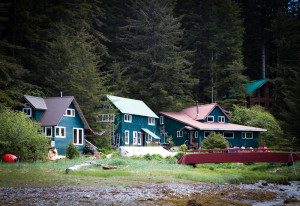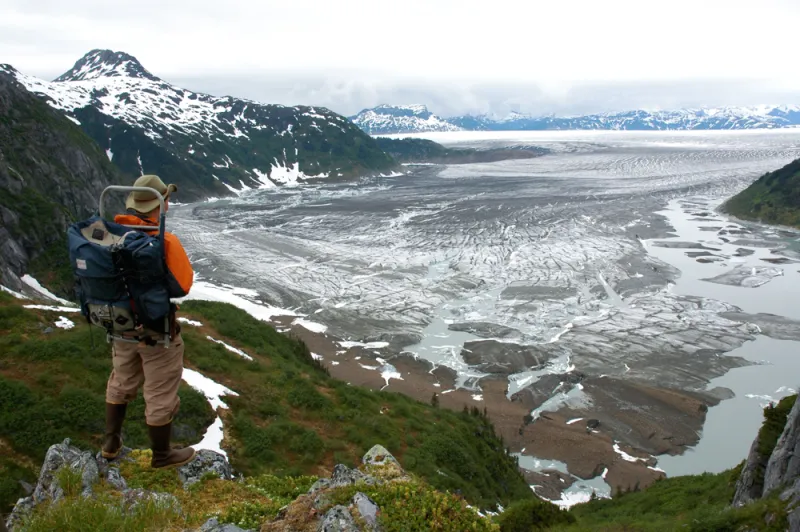
Zach Brown, a sixth-year Ph.D. student in the Department of Environmental Earth System Science, recalls some of the most memorable events in his life occurring at the Hobbit Hole, a five-acre property surrounded by wilderness in southeast Alaska.
Potlucks. Jam sessions. The weddings of childhood friends.
“People really enjoyed coming out there because there’s a real sense of affability and community that develops when you are all together in this small little place, on this island, in the midst of this abundant beauty,” Brown said.
The plot of land, resting between the world’s largest temperate rainforest and the Glacier Bay National Park, might become the site of another momentous occasion in Brown’s life. He and three other Stanford Ph.D. students have a plan to purchase the property and transform it into a nonprofit field school called the Inian Islands Institute, allowing students from Stanford and other universities to take month-long experiential learning classes on sustainability.
First, however, the group is working to raise funds for the project.
As of Wednesday night, a crowdfunding campaign on the site Indiegogo had generated around $19,500. The campaign has until Jan. 12 to amass the rest of its $40,000 goal, an amount that would go towards covering initial expenses: for instance, an official appraisal of the property, legal fees to become a nonprofit, promotional materials and the ability to invite potential donors to visit the remote Alaskan site.
“It’s an exciting thing to think about: bringing students out into the wilderness to think about ecology and conservation and human-environment interactions,” Brown said.
The founding four
His parents both employed by the National Parks Service, Brown grew up in Gustavus, Alaska. The small coastal town has a population of about 400 and is so isolated, Brown said, that his five-person basketball team had to fly by bush planes to get to games.
Geographically close to Gustavus, however, are the Inian Islands. Brown said these islands are uninhabited with one exception: the Hobbit Hole, which sits on a protected harbor and is comprised of three houses, a workshop and a dock.
For around 40 years, family friends owned and lived on the property, where they worked as commercial fishermen. Three years ago, however, they put the land up for the sale, announcing retirement from their labor-intensive lifestyle.
That’s when the idea of establishing an institute first came, Brown said.
After a chance meeting in Monterey, Calif., Brown later shared his thoughts with Lauren Oakes—a fifth-year Stanford Ph.D. student in the Emmett Interdisciplinary Program in Environment and Resources (E-IPER)—who conducted dissertation research in southeast Alaska.
“When Zach and I met, it was really clear that he also wanted to protect that place,” Oakes said. “He knew the Hobbit Hole was a place that holds a tremendous opportunity for education and research, but it could also potentially be bought by a lodge owner or someone who wants to do something very different there.”
Oakes jumped on board with the project, believing it was well matched with her own academic and personal interests.
“Alaska’s been amazing to me,” Oakes said. “I call it my monogamous relationship with a place.”
“That place just holds a remarkable capacity to teach people about environmental change,” Oakes said. “There’s a fascinating history of people with a deep connection to the natural resources, and I see us teaching sustainability in an area where students will have an immediate relationship with the resources that they rely upon.”
Lida Teneva Ph.D. ’13 in environmental earth system science and Aaron Strong, a third-year Ph.D. student in E-IPER, complete the founding-member quartet.
At first, the four would just meet up in the evenings and talk about the potential project over a few beers, Brown said. In the last year, however, the group has become more serious about the institute, drafting a business plan, recruiting members for its advisory council and launching a website.
Getting the idea off the ground
One of the most important initial steps, Oakes said, was drawing up a document listing the core values that would guide the project.
“Some of [the core values] have been maintaining a small program, protecting the place in its current state [and] emphasizing an interdisciplinary program,” Oakes said.
“It’s really easy to get distracted. Someone could have the idea, ‘Why don’t we make it a marine research institution?’” she added. “That sounds great, and obviously has value as well, but it’s a step away from what we–in a dream world–would like to do there.”
The first test of this dream came this September.
The group—along with Robert Dunbar, professor of environmental earth system science—led a three-week seminar based in southeast Alaska. Held as part of Stanford’s Sophomore College program, the course gave twelve rising sophomores the opportunity to learn resource management and long-term sustainability in the community of Sitka, Alaska.
At one point in the seminar, participants chartered a boat around 100 miles north to the Hobbit Hole and stayed on the property for several days.
“We thought about the issues of resources and sustainability on a real micro scale,” Brown said. “We were able to eat fresh-caught venison, salmon and halibut. We were able to utilize power generated right there on site by a micro hydro system.”
Brown said the seminar experience reaffirmed his desire to open the institute. After defending his dissertation in March, he hopes to return to the Hobbit Hole and lead the project year-round. The goal is to have the institute serve as the site of another Sophomore College course or similar college seminar in summer 2015.
Right now, however, the institute’s founders said they are focused on finishing the crowdfunding campaign and searching for a donor. They are also examining the feasibility of the project, acknowledging the high costs of working in remote southeast Alaska.
According to Strong, the money from the crowdfunding campaign will help move the project forward.
“In order to make this happen we are going to need a long-term strategy, but the first step is to actually acquire the property,” Strong said. “And to acquire the property, we need to raise awareness about our mission and get the property appraised. The crowdfunding campaign can help us accomplish those first steps.”
Oakes agreed that the goal is to make the institute a long-term project.
“We want to make this a sustainable program,” Oakes said. “Ironically, building the institute and making it work is forcing us to ask questions that run parallel to what we want to teach our students.”
Contact Kurt Chirbas at kchirbas ‘at’ stanford.edu.
